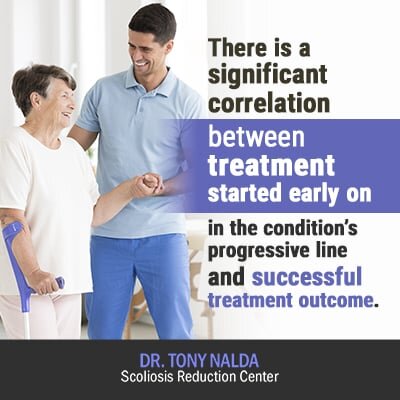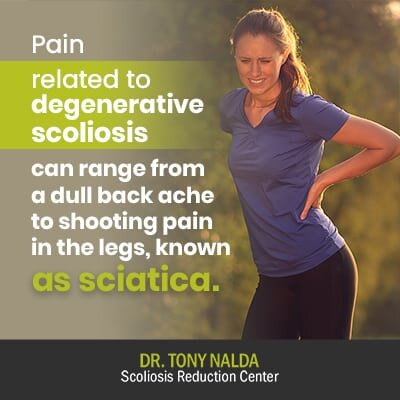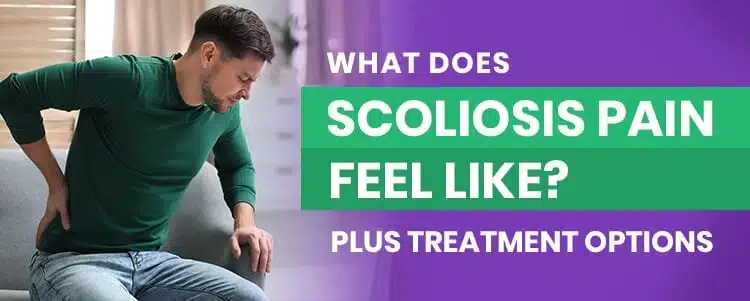Scoliosis isn’t necessarily painful, depending on factors such as the patient’s age, severity and form of the condition. For children and adolescents, pain isn’t a common symptom, which can make it difficult to diagnose. Adults, however, experience scoliosis-related pain very differently. Fortunately, with or without pain, there are a number of effective treatment options for both adolescents and adults.
As the condition varies so much between adolescents and adults, we’ll explore pain and treatment options in both groups. As the condition’s most common form, adolescent idiopathic scoliosis, is diagnosed between the ages of 10 and 18, we’ll start there.
Adolescent Idiopathic Scoliosis: Why Adolescents Usually Don’t Experience Scoliosis Pain
When I say that adolescent idiopathic scoliosis (AIS) is the condition’s most common form, I mean that approximately 80 percent of diagnosed cases are AIS; that’s a huge number. The other 20 percent have known causes such as neuromuscular, degenerative, congenital, and traumatic.
Patients diagnosed with AIS have not yet reached skeletal maturity. The younger the patient is, the more growth and development their bodies have yet to go through. While we don’t know what causes AIS, hence the ‘idiopathic’ designation, we do know that growth is the biggest trigger for the condition’s progression.

What we also know is that patients who are growing have spines that are constantly experiencing a lengthening motion. That lengthening motion is what commonly makes the condition painless as the spine is not vulnerable to the compressive forces of the scoliosis. Once the spine stops growing, this changes.
In terms of suffering, this is a positive aspect of the condition, but in terms of early diagnosis, this makes it that much harder to catch the condition early on. There is a significant correlation between treatment started early on in the condition’s progressive line and successful treatment outcome.
When I say “successful treatment outcome,” I have to be clear that there is no curing scoliosis. As a progressive and incurable condition, successful treatment means achieving a curvature reduction and working to sustain those results.
While pain isn’t a common symptom of AIS, it differs greatly case by case. As the condition can range from mild to severe, the more severe a case is, the more likely it is that symptoms will be more extreme and noticeable.
For those experiencing pain, this can include back pain in the middle and lower back and can include radiating pain if nerves are facing compression.
Headaches can also be a painful component of the condition, related to tight muscles in the neck and impairment to the flow of cerebrospinal fluid.
In the majority of AIS cases, pain isn’t part of the experience, but in severe cases, back pain and headaches can occur.
When looking at how adults experience the condition, pain is much more prominent.
Pain and Adult Scoliosis: Idiopathic and De Novo
While the lack of pain in AIS contributes to the challenge of early diagnosis, this is the opposite in adults with the condition. In fact, it’s most often pain that brings adults in to see me, which is the case with most conditions.
Although we don’t like experiencing pain, it plays a crucial role in maintaining the body’s health and wellness; it tells us when something is wrong and leads to diagnosis and treatment.
Adult Idiopathic Scoliosis
When adults have scoliosis, the majority of times, these are cases of idiopathic scoliosis from adolescents who had the condition but were unaware. They went through their adolescence without a diagnosis and treatment, and it’s not until they reached skeletal maturity that the spine became vulnerable to the compressive forces of the curvature. This compression can affect the spine, its surrounding muscles, and nerves.
The compression caused by scoliosis can lead to back pain, but most commonly, it’s radiating pain in the legs and feet that bring adults in to see me. Weakness and numbness are also common aspects of scoliosis-related pain and related nerve issues.
There is another form of the condition: adult de novo scoliosis.
Adult De Novo Scoliosis
Cases of adult de novo scoliosis differ as patients have no prior history of the condition; it develops fresh in adulthood.
This form of the condition can be a secondary complication of a more serious medical issue such as a neuromuscular condition like cerebral palsy or muscular dystrophy. Most commonly, it falls into the degenerative scoliosis classification and is the result of degenerative changes the spine is facing.
In degenerative scoliosis, this most often involves erosion of the discs that sit between the vertebrae of the spine. These spinal discs act as cushions, helping to absorb and distribute force evenly throughout the spine.

With erosion and degeneration of these discs, the spine can slip out of alignment, causing scoliosis to develop. Pain related to this form of the condition commonly affects the middle and lower back and can also lead to weakness and numbness in the legs and feet; often, it’s a pinched nerve that is the cause of the pain, and not the actual curvature.
Pain related to degenerative scoliosis can range from a dull back ache to shooting pain in the legs, known as sciatica. Again, symptoms like pain can vary greatly, depending on factors such as the patient’s age and severity of the condition.
What to do When You Start Experiencing Scoliosis Pain
As we discussed, pain is not commonly characteristic of how adolescents experience scoliosis. Whether pain is present or not for adolescents, the best approach is to treat the condition proactively. That way, the underlying cause of the condition is being addressed, and as a condition improves through active treatment, related symptoms, such as pain, will improve as well.
Here at the Scoliosis Reduction Center®, that active treatment would include a combination of disciplines because that is what the nature of scoliosis necessitates to actively manage its progression.
We deliver an integrative approach that combines scoliosis-specific chiropractic, therapy, rehabilitation, and corrective bracing.
Each and every case is different, which is why I’ve never used the same treatment plan for multiple patients. We monitor the results, through observation and X-ray, to see how the spine is responding to our approach and modify it accordingly. Sometimes these modifications include apportioning the disciplines accordingly.
When it comes to adolescent idiopathic scoliosis, growth is constantly occurring and affecting the spine, so when I see growth in an adolescent patient, I’ll order an X-ray to see if that growth is triggering progression; then we adjust our treatment plan to try and stay ahead of any progression that is occurring.
The end goal of treatment is to achieve a curvature reduction and sustain those results during and after treatment. We work closely with our patients to ensure they have all the knowledge and access to resources they need to maintain the results we have achieved; mainly, this involves augmenting the results with at-home exercises and stretches.
Adult Scoliosis
If an adult is experiencing scoliosis-related pain, the best strategy is still to seek out active treatment that addresses the underlying condition, and not just a symptom of it.
If an adult opts for medication or injections to deal with the pain, this is a quick fix that might alleviate pain for the short term, but it does nothing to actually treat and manage the condition.
In adults, progression tends to slow down because the main trigger for rapid progression (growth) is no longer occurring. Most often, adults who are 40+ are the most likely to experience scoliosis-related pain as they are facing the natural degenerative changes to the spine that can accompany aging.
For any type of permanent pain relief, a curvature reduction needs to occur. With adults, our treatment goal is to reduce the curvature to where it was before the condition became painful.
Here at the Center, that approach would include the same disciplines as mentioned for treating AIS, although corrective bracing plays less of a prominent role in treating adult scoliosis.
As is the goal with adolescent scoliosis, we want to work with our adult patients to achieve a curvature reduction, stabilize the spine, and empower them so they can sustain treatment results through at-home exercise and continued chiropractic care.
Conclusion
As Scoliosis is a progressive condition with no known cure, you can see how important it is to develop a strategy for managing it effectively; this is key to living your best life with the condition.
The most important decision is choosing the treatment approach that you will engage in. The first thing I tell people is to ensure they are working with a scoliosis specialist who is trained in multiple modalities.
Seeking out treatment from a general practitioner, regardless of how good they are, will most likely result in treating symptoms of the condition, rather than the condition itself. This path is also the most likely to end in a recommendation for spinal-fusion surgery, and this is an invasive and costly procedure that carries heavy side effects and potential risks.
If you are experiencing scoliosis-related pain, this is a strong sign that you are in need of scoliosis-specific active treatment. Here at the Scoliosis Reduction Center®, we provide each and every patient with a fully customized treatment plan that offers the best possible prognosis through a natural and conservative approach.




